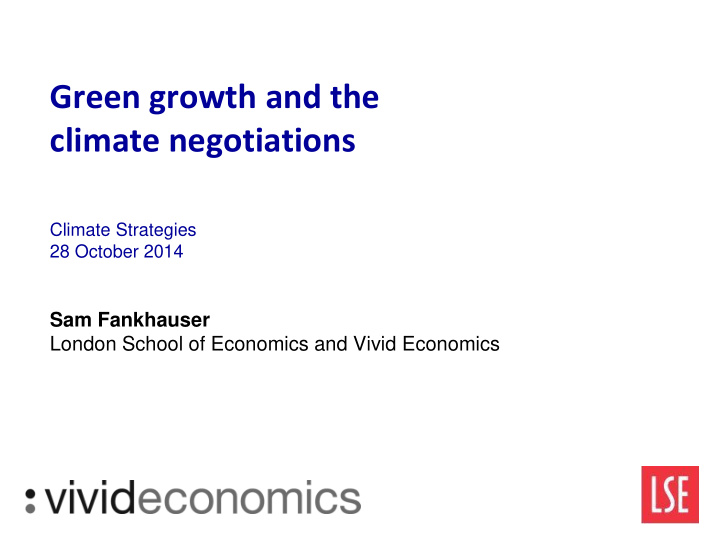



Green growth and the climate negotiations Climate Strategies 28 October 2014 Sam Fankhauser London School of Economics and Vivid Economics
Overview • Green growth narrative identifies actions that are in countries self-interest • Can this create a virtuous circle for the negotiations?
Green growth: The Keynesian story In the short term green investment can help to kick-start a sluggish world economy (Green Fiscal Stimulus) John Maynard Keynes Source: Bowen and Fankhauser, Global Environmental Change, 2011 3
Green investment to boost aggregate demand? High green capital needs at a time of low aggregate investment Investment ratios (investment / GDP) Source: Llewellyn Consulting
Green growth: The Pigouvian story In the medium term green policies can help to overcome existing market failures that hold back growth (e.g. pollution) Arthur Cecil Pigou Source: Bowen and Fankhauser, Global Environmental Change, 2011 5
Level of carbon tax justified by domestic benefits (Brazil is already overtaxing certain fuels) Source: IMF (Parry et al. 2014)
Green growth: The Schumpeterian story In the long term green innovation may trigger a cycle of “creative destruction”, productivity improvements and growth Joseph Schumpeter Source: Bowen and Fankhauser, Global Environmental Change, 2011 7
The social benefit of green innovation Green patents have higher benefits than dirty patents • Clean patents are cited more often • Clean patents have more general applications • Clean-patent knowledge spillover is similar to IT patents • Patterns hold over 4 technological fields ‒ Energy production, automobiles, fuel and lighting Source : Dechezleprêtre, Martin and Mohnen, Knowledge spillovers from clean and dirty technologies, Grantham Research Institute, 2013 8
Overview • Green growth narrative identifies actions that are in countries self-interest • Can this create a virtuous circle for the negotiations?
Countries are legislating on climate change Survey of 66 countries found ca 500 climate or climate-related laws Many laws are motivated by domestic factors (pollution, green growth) Source: Nachmany, Fankhauser et al, The Globe Climate Legislation Study 2014
Could there be a virtuous circle? Climate change legislation is determined by laws passed elsewhere Explaining the passage of climate laws Variable All countries Annex 1 countries Peer effect (stock of laws elsewhere) 0.159*** 0.190*** (0.061) (0.059) Hosting a COP 0.680*** 0.815* (0.237) (0.444) Kyoto effect (laws 1997-2001) -5.601* 4.673 (3.250) (3.237) Observations 1,383 418 Clustered standard errors at the country level in parentheses *** p<0.01, ** p<0.05, * p<0.1. All regressions include domestic control variables and country and time fixed effects Source: Fankhauser, Gennaioli and Collins, submitted
Conclusions • Many carbon policies are in countries’ self - interest • Countries are beginning to take action • This in turn encourages action elsewhere • Measures do not add up to 2 o C, but might over time change negotiation dynamics
Recommend
More recommend